Sitmar
Line - TSS Castel Felice
Please Note: Firefox and some other
search engines are not suitable – Use “Internet
Explorer” for this page to load perfectly!

Click
the logo above to reach the ssMaritime FrontPage for News Updates &
“Ship of the Month”
With Reuben
Goossens
Maritime Historian,
Cruise‘n’Ship Reviewer & Author
Please
Note: All ssMaritime
and other related maritime/cruise sites are 100% non-commercial and privately
owned. Be assured that I am NOT associated with any shipping or cruise
companies or any travel/cruise agencies or any other organisations! Although
the author has been in the passenger shipping industry since 1960, although is
now retired but having completed around 690 Classic
Liners and Cargo-Passengers Ships features I trust these will continue to
provide classic ship enthusiasts the information the are seeking, but
above all a great deal of pleasure! Reuben Goossens
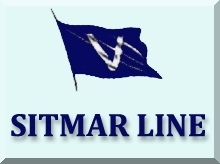
The
Sitmar Ships
Part
Two
TSS Castel Felice
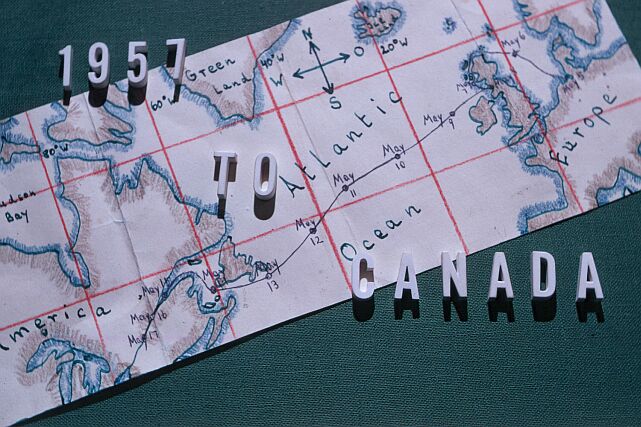
This
delightful story was kindly sent in by Mr. W. D. Hempel of Canada and I am delighted to
present it. Please Note: I have slightly edited the item but this has not changed
any of the details or in any way altered the style of writing.
Reuben Goossens.
Maritime
Historian.
My Voyage
from Bremerhaven to Quebec
on the TSS Castle Felice in 1957
By Mr. W. D. Hempel
“Thursday,
May 2nd 1957, the day of my departure arrived. We had agreed that mother would
not see me off in Bremerhaven.
It was a sunny spring afternoon and I had left by bus, carrying my hand
luggage. It was just a short good bye. In a way we were all rather sad and
apprehensive at the same time. But this time, my leaving home was very
different and not a big secret, everything was in the open. This time it was
not a matter of life and death like it was in 1951 when I left East Germany.
Now I knew that if Canada
would not give me what I expected, I always could come back; I had sufficient
for a return voyage. In Aachen I boarded the
night train for Bremen.
Arriving there I checked into a hotel and contacted the Sitmar Line office. I
had to be in Bremen
24 hours prior to departure. I thought that all the paperwork had been done in
advance, because of the numerous documents I had filled out earlier and mailed
to the agency in Bremen.
Passport, visa, health certificate and several other papers had been
scrutinized and verified with all the other documents like ticket and boarding
pass. By noon I had all
these chores completed and I went sightseeing in the afternoon.
Next morning at 10 AM the special train left for Bremerhaven. It contained passenger cars and
freight cars. It was a slow trip, it seemed to take forever. We arrived at the
pier at 1.30 PM, taking a long 3 ½ hours for just 80 km!
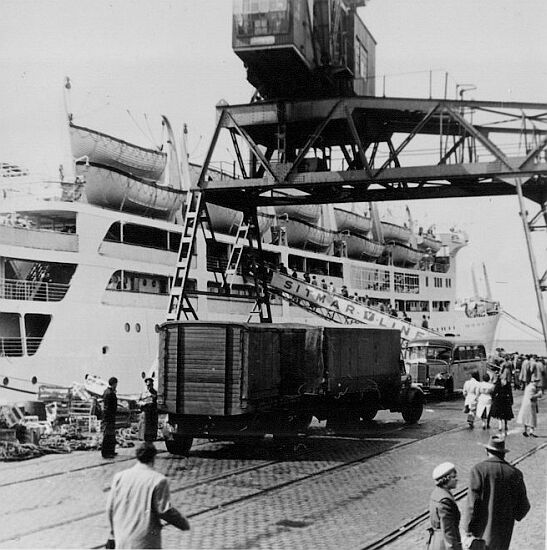
There she was what seemed like big white ship
with a yellow funnel with a big blue V on it being the TSS
Castel Felice, which was an Italian liner.
We had to remain in the train, but they
started immediately to unload the freight cars and slinging the luggage in huge
nets on board. My over sea trunk and suit cases were already sent to Bremen 4 weeks before
departure!
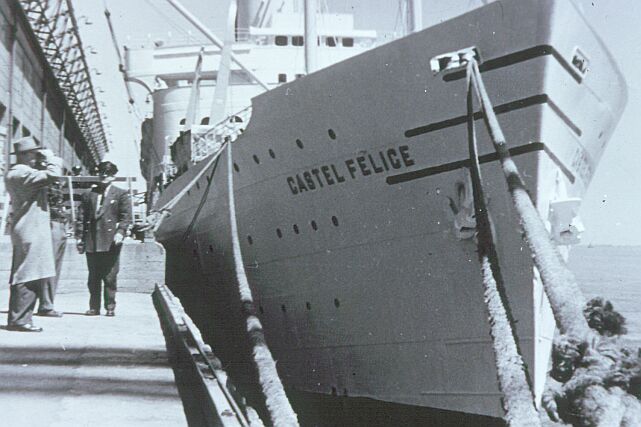
Around 3 PM we started boarding.
There were around 900 passengers boarding in Bremerhaven. We were soon ushered up the
gangway, after a last identification check on deck a cabin steward led me to my
cabin. My suitcases were already waiting for me in the cabin. I went up to the
main deck, strolling about, watching the remaining passengers coming aboard. No
visitors were allowed on board, all the farewell and good byes had to
“executed” on the quay, and it was very emotionally for all
“participants” directly involved. I, standing on the deck, looking
upon these scenes, felt strangely rather detached. The brass band on the dock
was playing various sentimental songs about the fatherland, the home town and
the beloved ones you leave behind. Every so often a whiff of smoke, from the 3
tugs tied to the ship on the waterside, drifted across the deck. Sharp at 5 PM
a wailing blast from the ships horn chattered everyone's emotional thoughts.
The last official and the pilot came aboard and the gangways were removed.
Passengers and left behind family waving to each other for the last time, many
of them crying. In a way I was glad that my mother wasn't there it would have
been too hard for her. My eyes did not get wet and I did not regret leaving Germany. The
lines had been cleared, then there was a faint shutter and I realized the tugs
were doing their job; there was one on the stern and two at the bow. Slowly the
liner was pulled sideways away from her berth some small eddies formed between
the berth and the ship. The dock slipped further and further away. The hold
back tug on the stern had to cut his lines, the bow tugs delivered full power
now, black smoke and sparks belching out of their stubby funnels, they left a
frothy trail to the port and starboard of the liner. Another double blast from
the ships horn and they too cut their lines. I was standing on the afterdeck,
looking back to Germany, to Bremerhaven, lit up in
the evening sun; I could feel the faint vibrations of the steam turbines,
pushing the 12,000 tons of steel through the water.
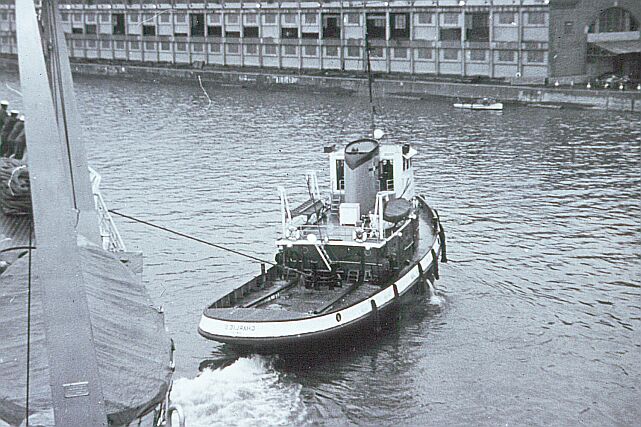
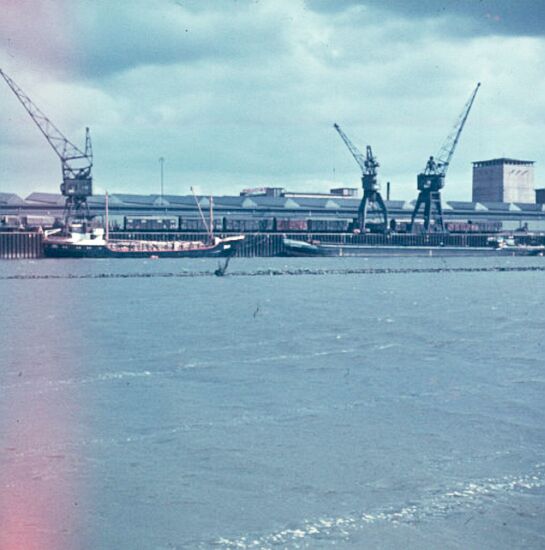
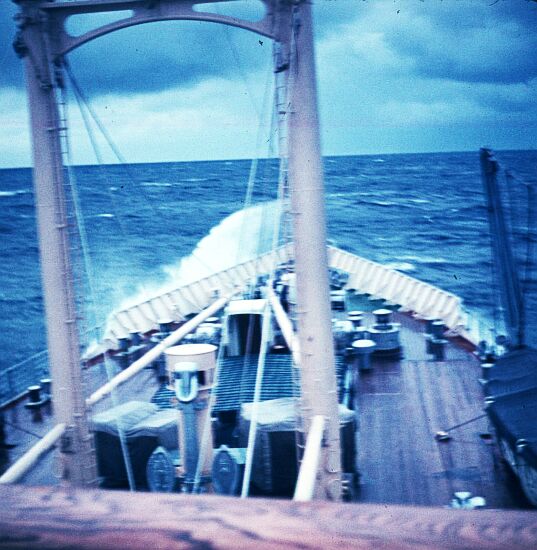
Toward the north there was a
storm was approaching as the sky was black. Was this an omen? It certainly
looked forbidding. Now after all these years in Canada I know, it was an omen, but
a good one. It taught me, not to be afraid of a dark future, to a certain
extent we can shape our future, for we have an input, and we reap what we seed.
In the open sea the waves were getting heavy.
The ship stopped, the pilot boat heaved along the lee. Now we were alone, Helgoland was hidden in a squall and we were heading into
the dark of night.
The sea was getting progressively heavier and people
were getting seasick. I survived the night very well, but next morning, after I
getup, I felt a little woozy. For breakfast I only had some tea and a few
biscuits. By noon we were
steaming northward within sight of the Scottish east coast. But by now the sky
had cleared but the sea was still quite heavy. We rounded the northern tip of Scotland between the Northern
Highlands and the Orkney
Islands. Early morning, around 4 AM, we berthed at Greenock,
Scotland, The harbor
of Glasgow. More
passengers were taken aboard. At 4 PM
at high tide, we put to sea again and commenced our crossing of the Atlantic Ocean.
The funnel was belching black smoke and the
ship was heaving in the swell of the ocean against a strong west wind. One day
out at sea we had a life boat drill. Every passenger had to know which life
boat station was theirs. The upper deck was off limits, because it was
completely covered with life rafts. Life boats have to be launched, but these
rafts would float by themselves after the ship sinks. It was May and we would
head into icebergs, the Titanic somehow came into my mind.
Within a day everything was routine,
breakfast, lunch and supper. To feed all these people was done in two sittings.
everyone had his assigned time and place, in other words you were
“stuck” with your table partner, but somehow the passenger were all
“Auswanderer” immigrants, people, made
all from the same “stuff” looking for a new land to live, all with
the same interests. Somehow, no matter who you were talking to, you always had
a pleasant conversation.
The ships doctor was a German, he had been
with this ship for several years and he showed me the huge “patch”
on the hull of the port side, as it had an “accident”, when she was
rammed by a freighter. I questioned him, why people get seasick, he explained,
the constant “jerking” around of the balancing system in the inner
ear during heavy sea affect the nervous system in such a way, that you feel
lousy and in most instances makes you puke. It is very similar as drinking too
much booze. But, he said, drinking a small amount of alcohol in advance will
prevent seasickness. But how do you know, how much to drink? Simple, while
drinking, every so often try to walk a straight line, (lines on the floor), if
you step off the line, lay off the booze for a while. In fact, being that
“drunk”, hardly impairs you, probably for driving an automobile,
for split decision making it is too much. In this state, I think I function
perfectly normal.
One beautiful sunny afternoon, low on the
western horizon, it looked like land, but these were storm clouds. The foredeck
was cleared of passengers, on the main deck, protective plates were placed onto
the windows, facing the foredeck. The doors facing the foredeck, similar to the
ones you see in submarine movies, were also “screwed” shut. I went
into my cabin, but what was happening, the stewards put on the “dead
lights”, (Portholes) and they had closed the steel “lids” on
the bull eyes. They mumbled it is going to be a bad storm. I went to the bar to
initiate the doctors remedy.
The storm hit with might. I went onto the
wings of the bridge and tried to get a few pictures. Only one of them turned
out halfway, most of the time I was engulfed in spray and I had a hard time to
keep the salt water off the camera.
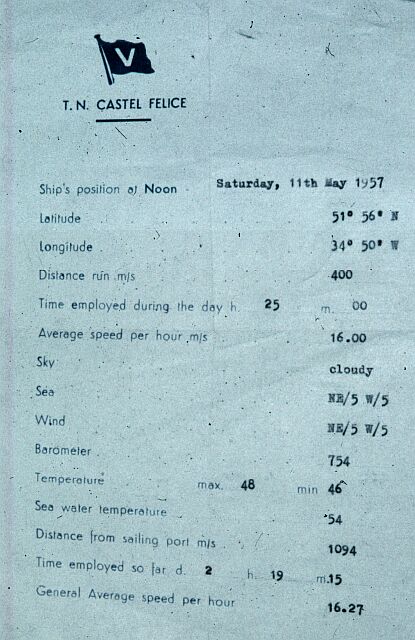
The doctor’s prescription
helped, I felt fine. The menu for supper was changed. There was no hot meal,
only sandwiches. Normally the dining room held 600 people, but this evening
there were only a few, maybe 2 dozen. All tables had ledges, which were
normally hidden underneath, folded up, and a soaking wet tablecloth slopped
over it, to make it sticky, so the plates would not slide all over the place.
Cups had to be held in the hand, they would tip over. The ship was rolling and
pitching badly, when you walked you had to brace yourself. After supper I
didn’t go down to my deck, because the innards of the ship smelled
horrible, sick people had puked all over. I stayed in the bar till the
“wee” hours, listening to some non seasick
“professionals” telling horror stories about ships sinking in a
storm. In the meantime the crew was busy cleaning up the mess and the
ventilation system did the rest. Finally I went to my cabin. When I came onto
the A – Deck, I realized how bad the storm actually was. I hit the A-Deck
about midships, normally I could see right to the last cabins at the stern. Now
they were actually twisting out of sight, either to the top or bottom, I turned
around, the bow the same way. The whole structure of the ship was creaking and
groaning. When the stern was twisted toward the bottom out of sight, the stern
of the ship was actually in the air, and not supported by the water, because in
that instance the propellers were out of the water and speeding up. When they
hit the water, you could hear that, the vibrations took on a different pitch. I
had read, ships breaking in half in heavy seas, after experiencing this, I
don’t doubt that. Actually, when I was standing there, looking around and
hearing all these weird noises, I wondered if the Castel Felice would stay
together. In the cabin everybody was moaning and pretty sick. I felt fine, but
could not fall asleep. One of the guys’ briefcases was lying on the floor
and with the rolling of the ship slid from on side of the cabin to the other, I
was watching it. Suddenly the cabin door opened with the rolling, I guess when
I had come in, and I hadn't closed it properly. When the vessel rolled over to
starboard it closed again and the briefcase slid against the closed door. I
watched this game of opening and closing the door and the sliding of the
briefcase for quite awhile. But then, the door somehow did not close, and the
briefcase was in the hall. I got up, secured the briefcase and closed the door,
end of the game and I fell asleep.
Next morning, the storm had lost its
fierceness, I, and only a few others had breakfast. By midmorning many of the
half sick came onto deck to catch same fresh air. Later in the afternoon the
sun came out and everything went slowly back to normal.
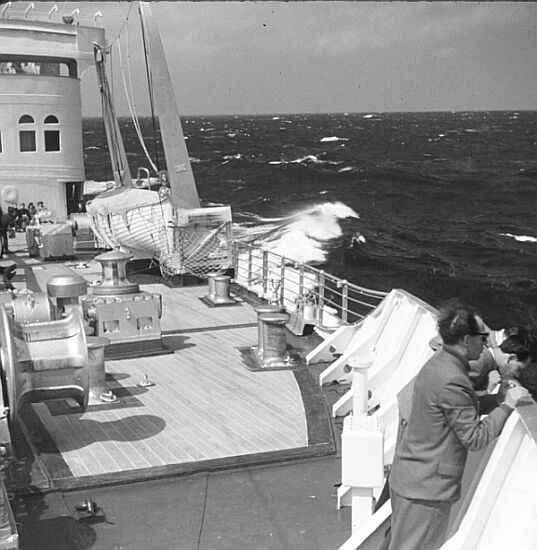
East of New Foundland,
the icebergs are coming down in spring from the Labrador
Sea. We crossed the “iceberg strait” during the night.
It was announced on the intercom, and most of the passengers went on deck. It
was eerie, the moon was shining brightly, the sea was like glass, the engines
dead slow ahead, we were hardly moving, and there, the icebergs were all around
us, I watched several hours, and still no end. I guess the captain knew what he
was doing, I went back to bed.
Next morning to our starboard was New Foundland, this early in spring, with its snow capped
mountains, and it didn’t take long we entered the St. Lawrence. The Atlantic was behind me, and so were my headaches. While
we were crossing the Atlantic I had all the time a weird slight headache,
probably caused by the constant up and down of the ship in the swell.
Quebec, the Liner had docked and it took a whole day to “put”
all the passengers through customs, in the late afternoon it was done, and we
continued upriver to Montreal.
Sometimes during the night we arrived, we had the last breakfast on board and
disembarked midmorning. The train station was right by the dock, in a small
store I bought same oranges, a ring of sausage and a loaf of bread. In my
ignorance I did not realize, that The Canadian of the CPR had a super dining
car. The following 30 hours on that train to Winnipeg, gave me the first glimpse of this
huge country.”
**********************************
The Castel Felice INDEX:
Castel Felice-1 - History Page.
Castel
Felice-2 -
Cabin Plan & the Robert Brinkhuis story 1965.
Castel Felice-3 - My 1957
voyage to Canada
by W. D. Hempel - This Page.
Castel
Felice-4 -
The Williams family sail to Australia
in 1957.
Castel Felice-4 - A
family’s voyage to Australia
- on
another site!
Or Return to:……The Sitmar Ships - INDEX - For all the Other Sitmar Ships!
“Blue Water Liners sailing
to the distant shores.
I watched them come, I watched them go and I watched them die.”
****************************
Return
to the ssMaritime Main INDEX
Where
you will discover around 690 Classic Passenger & Passenger-Cargo Liners!
ssMaritime.com & ssMaritime.net
Where
the ships of the past make history & the 1914 built MV Doulos
Story
Please
Note: ssmaritime and associated sites are
100% non-commercial and the author seeks no funding or
favours of any shape or form, never have and never will!
Photographs
on ssmaritime and associate pages are by the author or from the author’s private collection.
In addition there are some images that have been provided by Shipping Companies
and private photographers or collectors. Credit is given to all contributors.
However, there are some photographs provided to me without details regarding
the photographer/owner concerned. I hereby invite if owners of these images
would be so kind to make them-selves known to me (my email address may be found
on www.ssmaritime.com only), in order that due credit may be
given.
This
notice covers all pages, although, and I have done my best to ensure that all photographs are
duly credited and that this notice is displaced on each page, that is, when a
page is updated!
ssMaritime is owned & © Copyright by
Reuben Goossens - All Rights Reserved









